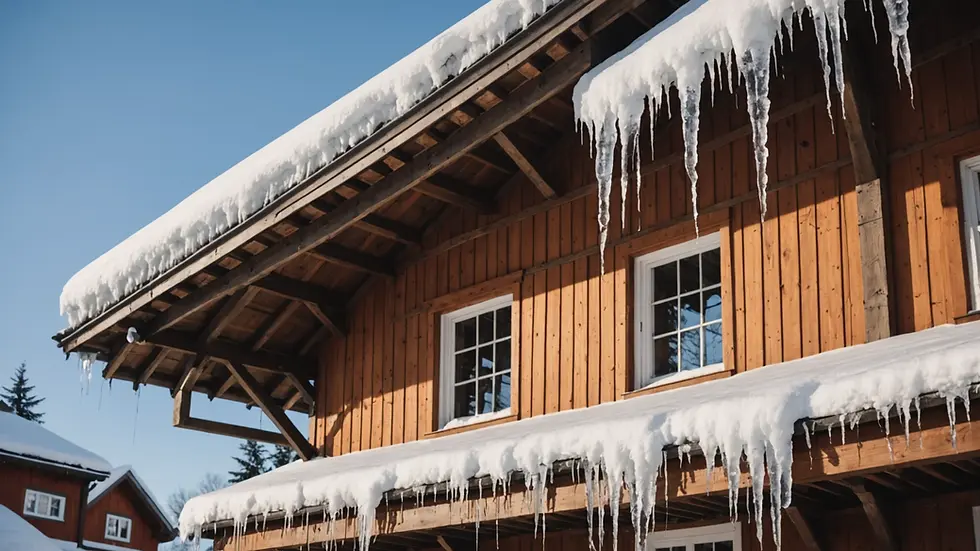Roofing and How to Protect Them
- Go2 General Contracting

- Feb 13
- 3 min read
Roofs are one of the most vital components of any building. They protect us from harsh weather elements, provide insulation, and contribute to the aesthetic appeal of our homes and businesses. However, the lifespan of a roof can be significantly influenced by various factors, including weather conditions, maintenance practices, and recent advancements in roofing technologies. In this blog post, we will explore essential roofing trends, preventive measures, the impact of weather on roofs, and new technologies that can help protect your roof.
Understanding Current Roofing Trends
In the roofing industry, staying updated with current trends is crucial for homeowners and contractors alike. Some popular roofing trends include:
Sustainability: More homeowners are opting for eco-friendly roofing materials such as recycled shingles, metal roofs, and living roofs. These materials not only reduce environmental impact but can also offer benefits such as better insulation and energy efficiency.
Cool Roofs: These roofs are designed to reflect more sunlight and absorb less heat than traditional roofs. They help in reducing energy costs by keeping homes cooler in summer months and are gaining traction especially in hotter climates.
High-tech Materials: Modern roofing technologies include synthetic materials that mimic the look and durability of traditional materials like slate or wood without their disadvantages. These advancements offer better resistance to environmental factors and require less maintenance.

Understanding these trends can help homeowners make informed decisions when it comes to roof installation or replacement.
Preventive Measures for Roof Longevity
Taking preventative measures can significantly extend the life of your roof. Here are some essential practices to consider:
Regular Inspections: Conduct thorough inspections at least twice a year, especially after severe weather events. Look for signs of damage such as missing shingles, leaks, or water stains on ceilings.
Cleaning Gutters: Clogged gutters can lead to water buildup, which can cause leakage and damage. Ensure your gutters are clean and flowing freely to direct water away from your roof.
Trim Nearby Trees: Overhanging branches can scratch and damage roofing materials. Regularly trim any branches that pose a risk to your roof.
By implementing these preventive measures, homeowners can protect their roofs from avoidable damage.
Weather Impacts on Roofing
Weather has a significant impact on the integrity and longevity of roofs. Different weather conditions can lead to various issues that require immediate attention:
Heavy Rain: Continuous exposure to heavy rain can weaken roofing materials and lead to water infiltration. Regular inspections are essential to ensure there are no leaks.
Snow and Ice: Ice dams can form at the edges of roofs during winter, preventing melting snow from draining. This can lead to leaks and structural damage. It's important to remove snow buildup regularly.
Extreme Heat: Prolonged exposure to the sun can cause roofing materials to deteriorate over time, leading to issues like cracking and fading. Cool roofs can mitigate some of these effects.

Being aware of these potential weather impacts can guide homeowners toward more effective protective measures.
Embracing New Technologies in Roofing
Innovation in roofing technology can provide homeowners with better options and improved protection. Here are some notable advancements in roofing technologies:
Smart Roof Systems: These systems use sensors to monitor roof conditions and alert homeowners to potential issues like leaks, temperature extremes, or structural weaknesses. This proactive approach allows for timely repairs.
Energy-efficient Roofing: Many roofing materials are now designed to enhance energy efficiency through improved insulation and reflective surfaces. This not only lowers energy bills but contributes to a homeowner’s sustainability efforts.
Solar Roofing: Solar shingles are becoming increasingly popular, allowing homeowners to harness solar energy without the bulkiness of traditional solar panels. This dual-functionality provides both roofing protection and renewable energy.
Incorporating these advanced roofing technologies can not only enhance the performance of a roof but also provide peace of mind.
Final Thoughts on Protecting Your Roof
Protecting your roof is a multifaceted endeavor that involves understanding current trends, implementing preventive measures, being aware of weather impacts, and embracing new technologies. Whether you’re a homeowner or planning documentation for a new construction project, investing time and resources into your roofing decisions will pay off in the long run.
Being proactive not only extends the lifespan of your roof but can also save you money on significant repairs or replacements down the line. By staying informed and making smart choices, you can ensure that your roof remains a strong and reliable shield for your home.

For further assistance and expert guidance, consider enlisting the help of professional contractors who understand the intricacies of roofing systems. After all, your roof deserves the best protection available!



Comments